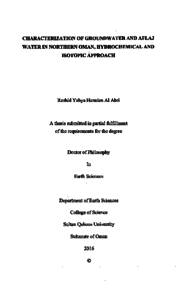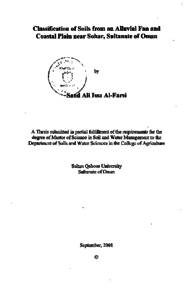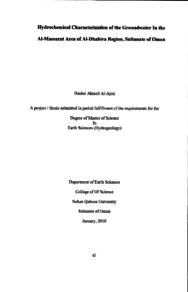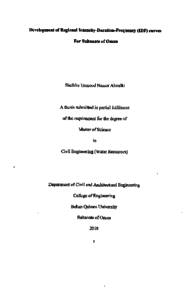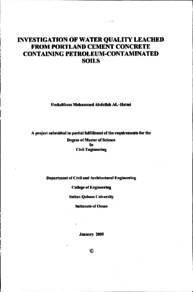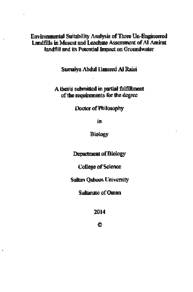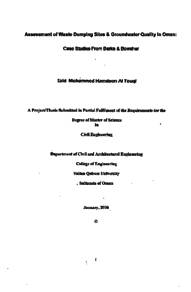Document
Characterization of groundwater and Aflaj water in northen Oman, hydrochemical and isotopic approach
Publisher
Sultan Qaboos University
Gregorian
2016
Language
English
Subject
English abstract
Abstract An in-depth study of groundwater resources in Oman is urgently needed due to the rapidly increasing demand and limited sources. The resulted deficit in water resources calls for integrated water management based on scientific and precise studies for these resources. Combining both hydrochemistry and isotopic studies is an effective approach for reliable understanding of groundwater occurrence, degree of renewability and quality. The main objective of this study is to use the proposed methodology to trace the water provenance and identify the processes that affect groundwater quality. The study also aims to explore the age of water hosted by different aquifers as well as the hydraulic connectivity (mixing) between these aquifers. In total 198 samples representing precipitation, groundwater and Aflaj water have been collected through extensive field trips and associated hydrogeological investigations. The samples were analyzed for major ions and isotopes of '80, 2H, PH, WC, Sr/Sr. Chemical analyses and isotopic results were combined to characterize of the groundwater which is mainly hosted in HSG, Ophiolite, Alluvium and Tertiary aquifers in the study area. The rainfall analyses show that more than one rainfall mechanisms may be active at the same time. The southerly, northwesterly, and local convective patterns have been observed to be active in the same time during this study. The isotopic composition of groundwater and Aflaj water suggests southerly moisture source usually originates in the Arabian Sea. However, the isotopic compositions of groundwater and Aflaj water show that the high altitude moisture is the main source for HSG aquifer in addition to Daoodi and Ainy Aflaj whereas the moisture controlled by low altitude and evaporation mostly affect Ophiolite, Alluvium aquifers and Ghaily Aflaj. Processes related to water-rock interaction such as dissolution are found to be the main factors that control the chemistry of groundwater. The cation exchange and the evaporation also have a role in modifying the groundwater chemistry. Water of Aflaj from the surrounded rocks indicates a degree of dissolution rock-forming minerals mainly carbonates and silicates. The evaporation process is more effective in the Ophiolite, Alluvium and Tertiary aquifers in addition to Ghaily Aflaj. Although the contribution of the recent recharge is demonstrated, "C and geochemistry results showed that Ophiolite and Tertiary aquifers in the southern part of the study area hosting paleo groundwater suggest different recharge within approximate age of 10000 - 20000 B. P. Apparent connectivity between different rock units is confirmed by aquifers of HSG, Ophiolite and Alluvium in addition to Aflaj water with chemical and isotopic signature of different aquifers. Based on this investigation, it was found that the water rock interaction and evaporation processes are the main factors affecting the groundwater quality hosted by different aquifers in Northern Oman
Member of
Resource URL
Arabic abstract
تبدو الحاجة ملحة جدا لدراسات متعمقة لموارد المياه في سلطنة عمان نظرا لمحدودية هذه الموارد وتنامي الطلب عليها. إن الجمع بين دراسة الهيدروكيمياء ودراسة النظائر يعتبر أداة فعالة لفهم أعمق لمصادر المياه وكذلك جودتها ودرجة تجددها. إن العجز المسجل في الموارد المائية يتطلب إدارة متكاملة للموارد المائية مبنية على دراسات علمية دقيقة مستفيضة لهذه الموارد. الهدف الرئيسي لهذه الدراسة هو تتبع مصادر المياه الجوفية ومياه الأفلاج في شمال عمان وتحديد العمليات الطبيعة المؤثرة على جودتها. وتهدف الدراسة أيضا إلى تحديد عمر المياه التقريبي في مختلف الخزانات الجوفية الحاملة للمياه وهي خزانات الحجر الجيري والأفيوایت والطمي والثلاثي وعلاقة هذه الخزانات ببعضها البعض. لقد تم جمع حوالي 198 عينه تمثل مياه الأمطار والمياه الجوفية ومياه الأفلاج وذلك من خلال برنامج حقلي مكثف شمل أيضا دراسة المنطقة من الناحية الجيولوجية والهيروجيولوجية. تم تحليل العناصر الأيونات الرئيسية وكذلك الأكسجين (18) والهيدروجين (2) والهيدروجين (3) و الكربون (14) والسترنشيوم(87) ومن ثم تم ربط نتائج التحاليل ببعضها لتكوين صورة متكاملة عن المياه الجوفية ومياه الأفلاج من النواحي الهيدروكيميائية. بينت التحاليل أن منطقة الدراسة تتعرض الأكثر من نمط مطري ويمكن أن تكون نشطة و مؤثرة في نفس الوقت. أوضحت الدراسة أن مياه الأفلاج الداوودية والعينينة ومياه الحوض الجيري مصدرها الغالب هي الأمطار الجنوبية المتكونه في بحر العرب والمتأثرة بالإرتفاعات العالية بينما تتأثر باقي المياه في باقي الأحواض المائية والأفلاج الغيلية بالأمطار الجنوبية المتأثرة بالإرتفاعات المنخفضة. وقد أظهرت الدراسة أن عمليات التجوية (تفاعل المياه والصخور) هي العومل الرئيسية المؤثرة على كيمياء المياه في مختلف الخزانات الجوفية وكذلك مياه الأفلاج بالإضافة إلى تاثير عمليات التبخر والتبادل الأيوني عكست تحاليل مياه الأفلاج نوعية الصخور الخازنه لهذه المياه مما يدل على عمليات التجوية والإذابة المؤثرة على هذ المياه. ووجد كذلك من خلال هذه الدراسة أن عمليات التبخر أثناء هطول الأمطار وأثناء سريان المياه إلى باطن الأرض تؤثر بشكل أكبر على المياه الجوفية في كل من خزان الأفيوليت والخزان الطمي وكذلك الأفلاج الغيلية. وعلى الرغم من أن الدراسة أظهرت أن هناك تغذية حديثة لمختلف الخزانات الجوفية إلا أن المياه القديمة جدا تتواجد أيضا في مختلف الخزانات حيث أوضحت نتائج الكربون (14) والنتائج الجيوكيمائية أن بعض الخزانات مثل خزان الأفيوليت وخزات الثلاثي تحمل مياه تصل عمرها بين 1000 و 20000 سنة. أثبتت الدراسة الحالية كذلك وجود إتصال هیدرولیکي بين مختلف الخزانات المياه الجوفية وكذلك الأفلاج وان المياه المتواجدة في الخزات الجوفية للأفيوليت والثلاثي والطمي في معظمها مياه مختلطة. وبناء على هذه الدراسة فإن عمليات التجوية المائية والتبخر جميعها عوامل مؤثرة ومتحكمة في كيمياء وجودة المياه الجوفية في شمال السلطنة.
Category
Theses and Dissertations

